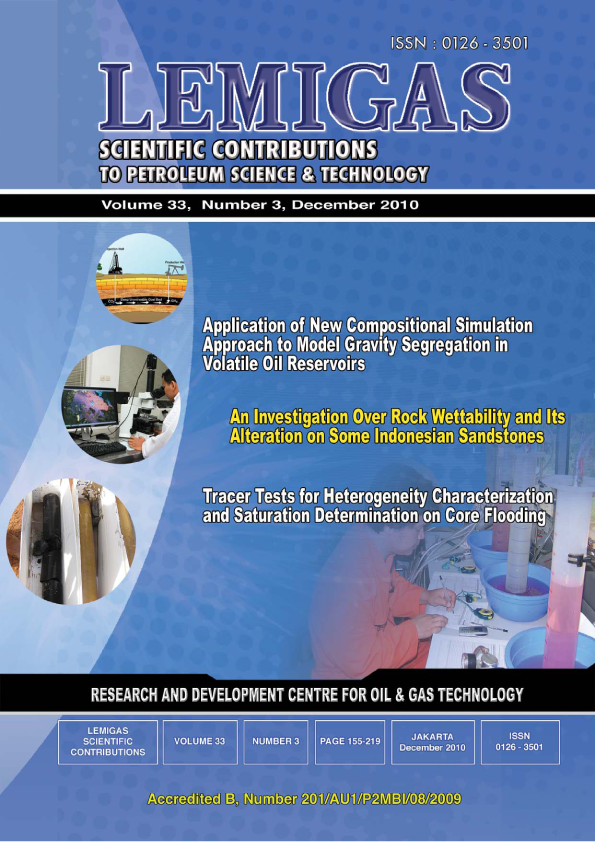An Investigation Over Rock Wettability And Its Alteration On Some Indonesian Sandstones
DOI:
https://doi.org/10.29017/SCOG.33.3.820Keywords:
wettability, sandstones, alteration, core cleansing, wettability degradation, misleading petrophysical data, cautious core handlingAbstract
Wettability is a reservoir rock property that is not easy to measure and quantify but has a crucial effect on other rock properties such as relative permeability, capillary pressure, and electrical properties. Problem that may occur with regard to this matter is that those properties are often measured on already cleansed core samples as part of the standard procedure. Having undergone the normally utilized heated cleansing process alteration in the rock’s original wettability was often reported. Under such condition, unrepresentative wettability certainly leads to unrepresentative measured data with all of consequences. This article presents a study that uses 363 sandstone samples retrieved from 28 oil and gas fields in Indonesia. The study consists of two stages of analysis. First analysis is performed on data obtained from three wettability tests results while the second one is made with using water-oil relative permeability data, that is usually measured on cleansed core samples. Original wettability data shows that the sandstones varry in wettability from water-wet to oil-wet (48.2% and 30.2% of total samples, respectively). Comparison between data of the two analyses shows that original wettability tends to degrade in strength after cleaning down to neutral wettability, among which neutral wettability appears to be the largest in number (49.1% of total sample). Results also show that weak wettability tends to endure more than stronger ones. The overall results have demonstrated the need for caution in core handling and for measures that can minimize the risk.
References
Amott, E. (1959). “Observation relating to the
wettability of porous rockâ€. Trans. AIME, Vol.
, pp. 156 – 162.
Amyx, J.W., Bass JR, D.M & Whiting, R.L.
(1960). “Petroleum reservoir engineering: Physical
propertiesâ€. McGraw-Hill Book Co., New
York, p. 610.
Anderson, W.G. (1986a). “Wettability literature
survey – Part 2: Wettability measurementâ€. Soc.
Petrol. Eng. JPT vol. 38, pp. 1246 – 1262.
Anderson, W.G. (1986b). “Wettability literature
survey – Part 5: The effects of wettability on
relative permeabilityâ€. Soc. Petrol. Eng. JPT vol.
, pp. 1453 – 1468.
API (1960). “Recommended practice for core
analysis procedure – API RP 40â€. The American
Petroleum Institute, August.
Archer, J.S. and Wall, C.G. (1986). “Petroleum
engineering: Principles and practiceâ€. Graham &
Trotman Ltd, Sterling House, 66 Wilton Road,
London SW1V 1DE, UK, p.362.
Block, A. & Simms, B.B. (1967). “Desorption
and exchange of absorbed octadecylamine and
stearic acid on steel and glassâ€. J. Colloid and
Interface Sci., Vol. 25, p.514.
Chilingarian,G.V. & Yen, T.F. (1983). “Some notes
on wettability and relative permeabilities of carbonate
rocksâ€. Energy Sources, Vol. 7, No. 1,
pp. 67 – 75.
Denekas, M.O., Mattax, C.C. and Davis, G.T.
(1959). “Effect of crude oil composition on rock
wettabilityâ€. Trans. AIME, vol. 216, pp. 330 –
Donaldson, E.C., Kendall, R.F., Pavelka, E.A. and
Crocker, M.E. (1969). “Wettability determination
and its effect on recovery efficiencyâ€. Soc.
Petrol. Eng. J., Vol. 9, No. 1, March, pp. 13 – 20.
Geffen, T.M., Owens, W.W., Parrish, D.R. &
Morse, R.A. (1951). “Experimental investigation
of factors affecting laboratory relative permeability
measurementsâ€. Trans. AIME, vol. 192, pp.
– 110.
Ma, S., Morrow, N.R. and Zhang, X. (1999).
“Characterization of wettability from spontaneous
imbibition measurementsâ€. J. Can. Petrol.
Tech. (Special Edition), Vol. 38, No. 13, p. 56.
Mattox, C.D. and Kyte, J.R. (1962). “Imbibition
oil recovery from fractured water drive reservoirâ€.
SPEJ, June, pp 177 – 184.
Mennella, A., Morrow, N.R. and Xie, X. (1995).
“Application of the dynamic Wilhelmy Plate to
identification of slippage at a liquid-liquid-solid
three phase line of contactâ€. JPSE, vol. 13, Nov.,
pp. 179 – 192.
Tiab, D. & Donaldson, E.C. (2004).
“Petrophysics: Theory and practice of measuring
reservoir rock and fluid transport propertiesâ€.
Gulf Professional Publishing, 200 Wheeler Road,
Burlington, MA 01803, USA, p. 889.
Timmerman, E.H. (1982). “Practical reservoir engineering
– Methods for improving accuracy or
input into equations and computer programsâ€.
PennWell publishing Company, 1421 South
Sheridan Road, Tulsa – Oklahoma 74 101, p. 365.
Treiber, L.E., Archer, D. & Owens, W.W. (1972).
“A laboratory evaluation of the wettability of fifty
oil producing reservoirsâ€. Soc. Petrol. Eng. J.,
Vol. 12, No. 6, December, pp. 531 – 540.
Widarsono, B. (2008). Perubahan Sifat
Kebasahan Fluida dan Sifat Kelistrikan
Batuan Reservoir: Isu Lama, Problem Aktual
(Change in Reservoir Rocks’ Wettability and Its
Influence on Electrical Characteristics: Old Issue,
Ever Present Problem). (in Bahasa Indonesia).
Lembaran Publikasi LEMIGAS, Vol. 42, No.
, April, pp: 20 - 28.
Downloads
Issue
Section
License
Copyright (c) 1970 SCIENTIFIC CONTRIBUTIONS OIL AND GAS (SCOG)

This work is licensed under a Creative Commons Attribution 4.0 International License.
Authors are free to Share — copy and redistribute the material in any medium or format for any purpose, even commercially Adapt — remix, transform, and build upon the material for any purpose, even commercially.
The licensor cannot revoke these freedoms as long as you follow the license terms, under the following terms Attribution — You must give appropriate credit , provide a link to the license, and indicate if changes were made . You may do so in any reasonable manner, but not in any way that suggests the licensor endorses you or your use.
No additional restrictions — You may not apply legal terms or technological measures that legally restrict others from doing anything the license permits.














